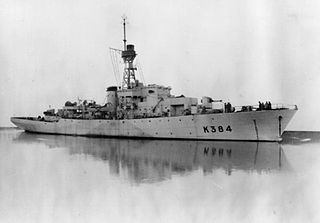
HMS Leeds Castle was a Castle-class corvette of the Royal Navy, originally with pennant number K384.
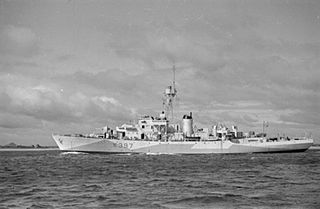
HMS Launceston Castle (K397) was a Castle-class corvette of the United Kingdom's Royal Navy, named after Launceston Castle in Cornwall. The ship was constructed during the Second World War and saw service primarily as a convoy escort.

HMS Thermopylae (P355) was a T-class submarine in service with the United Kingdom's Royal Navy. So far she has been the only ship of the Royal Navy to bear the name Thermopylae, after the Battle of Thermopylae.

HMS Tireless, a Taciturn- or T-class submarine, was the first ship of the Royal Navy to bear that name. She was authorized under the 1941 War Emergency Programme and her keel was laid down on 30 October 1941 at Portsmouth Dockyard. She was launched on 19 March 1943 and was completed on 18 April 1945.
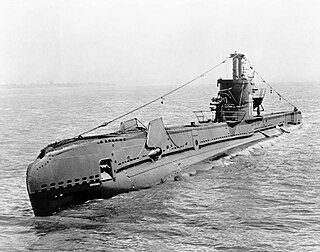
The S-class submarines of the Royal Navy were originally designed and built during the modernisation of the submarine force in the early 1930s to meet the need for smaller boats to patrol the restricted waters of the North Sea and the Mediterranean Sea, replacing the British H-class submarines. As part of the major naval construction for the Royal Navy during the Second World War, the S class became the single largest group of submarines ever built for the Royal Navy. A total of 62 were constructed over a period of 15 years, with fifty of the "improved" S class being launched between 1940 and 1945.

HMS Tradewind was a British submarine of the third group of the T class. She was built as P329 at Chatham, and launched on 11 December 1942. As of 2021 she is the only ship of the Royal Navy to have been named Tradewind, after the trade winds.

HMS Totem was a Group 3 T-class submarine of the Royal Navy which entered service in the last few months of World War II. To-date, she is the only ship of the Royal Navy to have been named Totem.

HMS Tenacious was a T-class destroyer of the Royal Navy that saw service during the Second World War. She was built by Cammell Laird, of Birkenhead and launched on 24 March 1943.

HMS Scorcher was an S-class submarine of the Royal Navy, and part of the third group built of that class. She was built by Cammell Laird and launched on 18 December 1944. So far she has been the only ship of the Royal Navy to bear the name Scorcher. She was launched by Thomas Beacham, a Foreman Driller employed by Cammell Laird.

HMS Sea Scout was a S-class submarine of the third batch built for the Royal Navy during World War II. She survived the war and was sold for scrap in 1965.
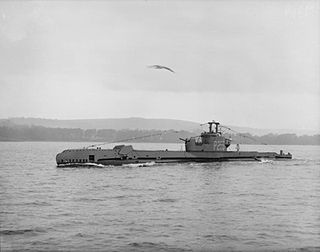
HMS Seneschal was a S-class submarine of the third batch built for the Royal Navy during World War II. She survived the war and was sold for scrap in 1965.

HMS Springer was an S-class submarine of the Royal Navy, and part of the Third Group built of that class. She was built by Cammell Laird and launched on 14 May 1945. So far, she has been the only boat of the Royal Navy to bear the name Springer.

HMS Sea Devil was a S-class submarine of the third batch built for the Royal Navy during World War II. She survived the war and was sold for scrap in 1966.

HMS Token was a British submarine of the third group of the T class. She was built as P328 at Portsmouth Dockyard, and launched on 19 March 1943. So far she has been the only ship of the Royal Navy to bear the name Token.
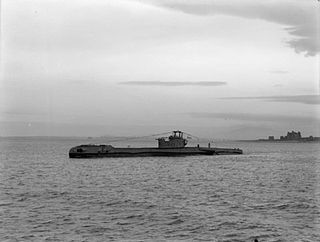
HMS Teredo was a British submarine of the third group of the T class. She was built as P338 at Vickers Armstrong, Barrow and launched on 27 April 1945. So far she has been the only ship of the Royal Navy to bear the name Teredo, possibly after a mollusc, the shipworm, of that name.

HMS Talent was a British submarine of the third group of the T class. She was built as P337(S37) by Vickers Armstrong, Barrow, and launched on 13 February 1945. She was originally to have been named HMS Tasman, but was this was changed to Talent after the previous HMS Talent was transferred to the Royal Netherlands Navy, this may have also been the case due to confusion with HMNZS Tasman in Lyttelton, New Zealand.

HMS Myngs was a Z-class destroyer of the Royal Navy built as a flotilla leader by Vickers-Armstrongs, High Walker. She served in the Second World War, taking part in operations in the North Sea and off the Norwegian coast, before taking part in some of the Arctic convoys. She spent a further ten years in Royal Navy service after the end of the war, before being sold to the Egyptian Navy, which operated her as El Qaher. She was sunk in an Israeli air attack on 16 May 1970.

HMS Crispin was a C-class destroyer of the Royal Navy built by J. Samuel White, Cowes between 1944 and 1946. She was originally to have been named HMS Craccher. She was sold to the Pakistan Navy in 1958 and renamed PNS Jahangir. She was scrapped in 1982.
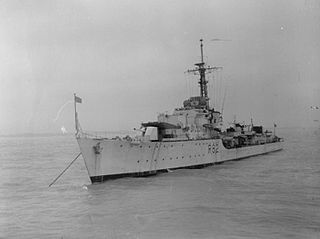
HMS Creole was a C-class destroyer of the Royal Navy built by J. Samuel White, Cowes between 1944 and 1946. She was sold to the Pakistan Navy in 1958 and renamed PNS Alamgir. She was scrapped in 1982.
Rahav has been borne by three ships of the Israeli Navy and may refer to:




















